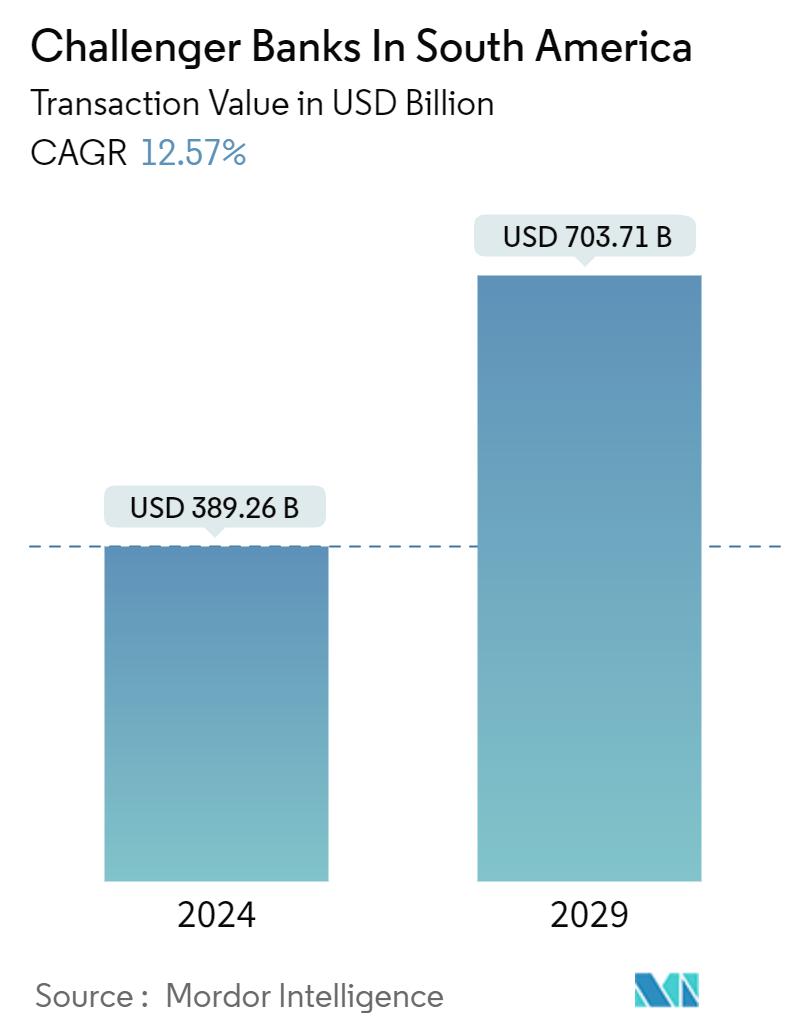Market Size of Challenger Banks In South America

| Study Period | 2020 - 2029 |
| Base Year For Estimation | 2023 |
| Market Size (2024) | USD 389.26 Billion |
| Market Size (2029) | USD 703.71 Billion |
| CAGR (2024 - 2029) | 12.57 % |
| Market Concentration | Low |
Major Players
*Disclaimer: Major Players sorted in no particular order |
South America Challenger Banks Market Analysis
The Challenger Banks In South America Market size in terms of transaction value is expected to grow from USD 389.26 billion in 2024 to USD 703.71 billion by 2029, at a CAGR of 12.57% during the forecast period (2024-2029).
The market is poised for notable expansion, propelled by the rising prevalence of digital banking throughout Latin America. This shift originated prominently in Brazil with the rise of regional leader Nubank. Targeting primarily tech-savvy, young consumers renowned for their readiness to switch between providers, these digital lenders have entered the market alongside standalone challenger banks and neobanks, benefiting from low entry barriers and minimal friction levels. Additionally, a multitude of fintech firms are reshaping conventional banking value chains, perpetually seeking fresh revenue avenues and market prospects.
Additionally, Chile's prepaid card market is witnessing growth, propelled by the proliferation of challenger banks and neobanks in South America. Noteworthy entrants include the local unit of Peru-headquartered financial services giant Credicorp. Furthermore, companies like B89 are seeking partnerships with financial institutions, as regulations mandate a physical banking presence. This evolving landscape underscores the dynamic nature of South America's banking sector, fueled by innovation and a shifting consumer landscape, presenting ample opportunities for growth and market expansion.
South America Challenger Banks Industry Segmentation
A challenger bank, on the other hand, is a smaller, newer bank aiming to compete or challenge these traditional banks directly using modern financial practices. Many have turned away from branch-based banking and operate solely online or through an app. A complete background analysis of the market, which includes emerging trends by segments, significant changes in market dynamics, and a market overview, is covered in the report.
The challenger banks in South America are segmented by service type and end-user type. By service type, the market is sub-segmented into payments, savings products, current accounts, consumer credit, loans, and others. By end-user type, the market is sub-segmented into business segment and personal segment. The report offers market size and forecasts for challenger banks in south america regarding transaction volume and revenue (USD) for all the above segments.
| By Service Type | |
| Payments | |
| Savings Products | |
| Current Account | |
| Consumer Credit | |
| Loans |
| By End-User Type | |
| Business Segment | |
| Personal Segment |
Challenger Banks In South America Size Summary
The South American challenger banks market is experiencing significant growth, driven by the increasing adoption of digital banking solutions across the region. This trend began in Brazil with the emergence of Nubank, a regional leader that has successfully targeted tech-savvy, young consumers who are open to switching between financial service providers. The market is characterized by the entry of standalone challenger banks and neobanks, which benefit from low entry barriers and minimal friction in their operations. The proliferation of fintech firms is further transforming traditional banking value chains, creating new revenue streams and market opportunities. The prepaid card market in Chile is also expanding, supported by the activities of challenger banks and neobanks, with companies like Credicorp and B89 playing notable roles in this evolution.
Challenger banks in South America are rapidly gaining popularity due to their digital-first approach, offering lower fees and superior customer service compared to traditional banks. The surge in fintech investments has been a key factor in their growth, enabling these banks to broaden their service offerings and reach a larger audience. Prominent players in the region include Nubank, Banco Inter, Neon, and C6 Bank. These banks are not only providing better financial services but also driving financial inclusion by reaching underserved and unbanked populations. The market remains fragmented, with established players like Nubank and Banco Inter leading, while new entrants continue to explore opportunities for market share. The recent exit of N26 from Brazil highlights the dynamic and competitive nature of the market, as companies adapt their strategies to focus on different geographical areas.
Challenger Banks In South America Market Size - Table of Contents
-
1. MARKET DYNAMICS
-
1.1 Market Overview
-
1.2 Market Drivers
-
1.3 Market Restraints
-
1.4 Value Chain / Supply Chain Analysis
-
1.5 Porter's Five Forces Analysis
-
1.5.1 Threat of New Entrants
-
1.5.2 Bargaining Power of Buyers/Consumers
-
1.5.3 Bargaining Power of Suppliers
-
1.5.4 Threat of Substitute Products
-
1.5.5 Intensity of Competitive Rivalry
-
-
1.6 Insights on Partnerships between Challenger Players And Other FinTechs
-
1.7 Latest Technologies Deployed by Challengers in Banking System
-
1.8 Performance Indicators of Challenger Banks
-
1.9 Industry Policies And Government Regulations
-
1.10 Impact of COVID-19 on the Market
-
-
2. MARKET SEGMENTATION
-
2.1 By Service Type
-
2.1.1 Payments
-
2.1.2 Savings Products
-
2.1.3 Current Account
-
2.1.4 Consumer Credit
-
2.1.5 Loans
-
-
2.2 By End-User Type
-
2.2.1 Business Segment
-
2.2.2 Personal Segment
-
-
Challenger Banks In South America Market Size FAQs
How big is the South America Challenger Banks Market?
The South America Challenger Banks Market size is expected to reach USD 389.26 billion in 2024 and grow at a CAGR of 12.57% to reach USD 703.71 billion by 2029.
What is the current South America Challenger Banks Market size?
In 2024, the South America Challenger Banks Market size is expected to reach USD 389.26 billion.

